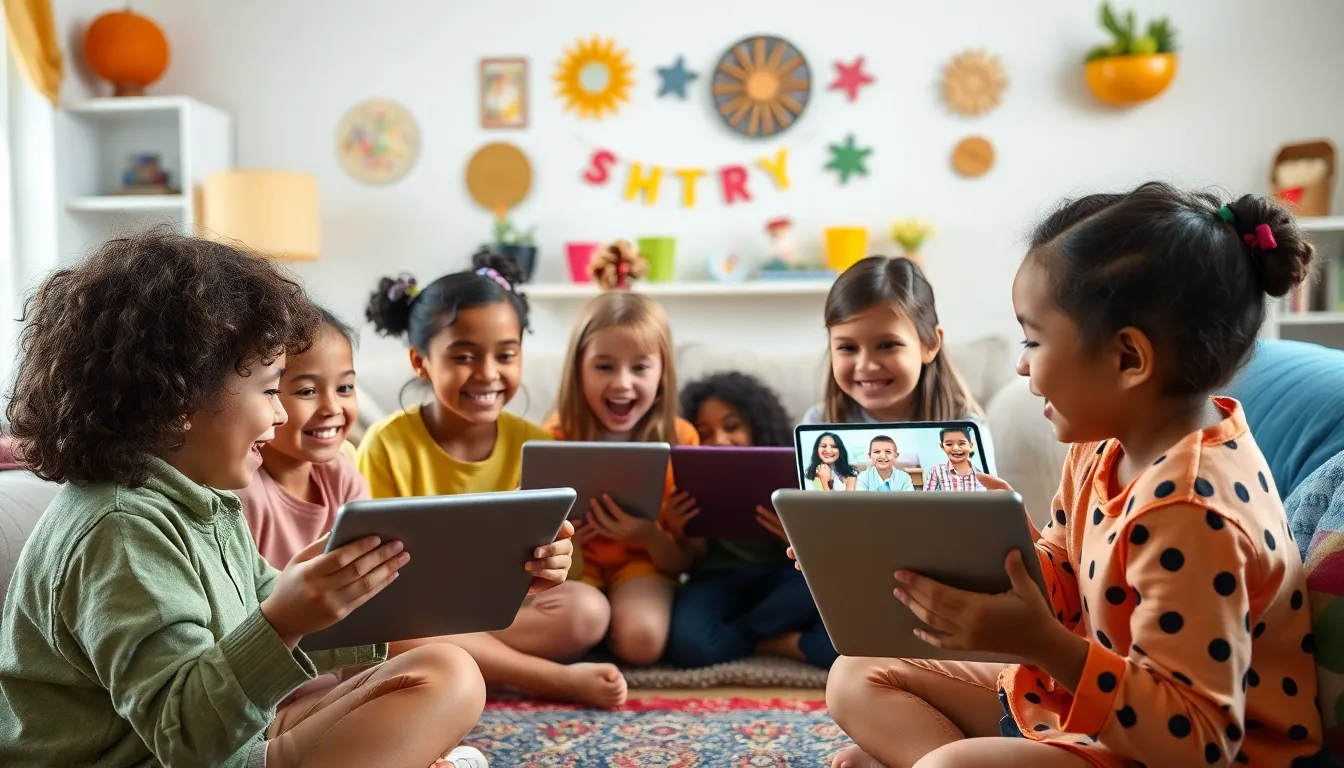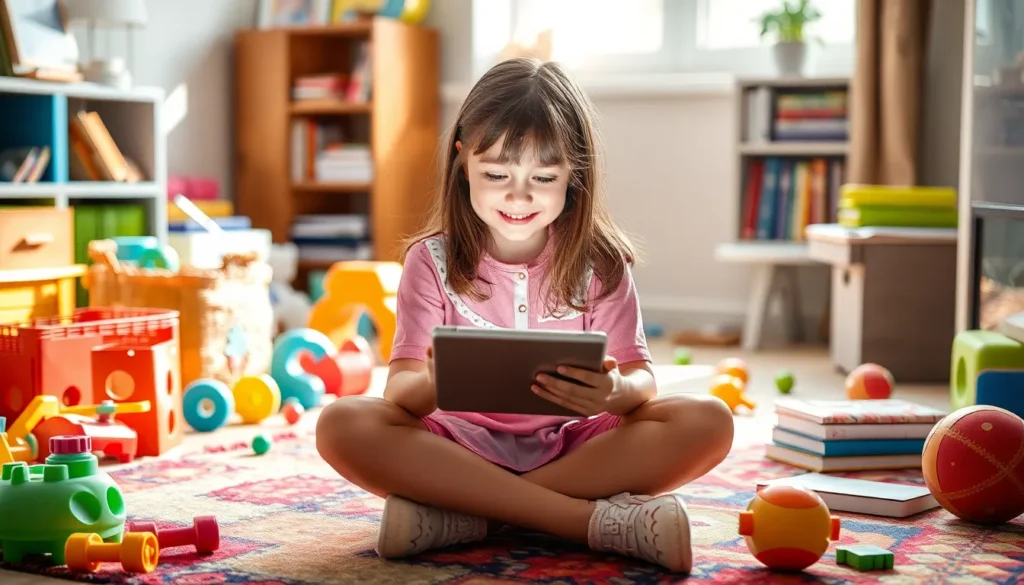Table of Contents
ToggleIn today’s digital age, kids seem to be glued to screens more than ever. Whether it’s a tablet, smartphone, or TV, those glowing rectangles have become a staple in family life. But how much screen time is too much? Parents often find themselves caught in a battle between keeping their kids entertained and ensuring they don’t turn into couch potatoes.
Understanding Screen Time
Screen time refers to the amount of time children spend engaged with screens, including smartphones, tablets, computers, and televisions. Various factors influence how screen time affects kids’ development, necessitating a clear understanding of its definition and types.
Definition of Screen Time
Screen time encompasses any activity involving a screen for recreational or educational purposes. This includes watching videos, playing games, or browsing the internet. Parents often question what constitutes healthy screen time. The American Academy of Pediatrics provides guidelines—children aged 2 to 5 should limit screen use to one hour of high-quality programming each day. For younger kids, under 18 months, screen use should be avoided, except for video chatting. Clarity around these definitions helps parents make informed choices regarding their children’s digital engagement.
Types of Screen Time
Various types of screen time exist, each impacting children differently. Recreational screen time involves activities like gaming or watching TV, often leading to more sedentary behavior. Educational screen time can provide valuable learning experiences through apps and interactive programs. Parents should recognize that not all screen time is the same. Therefore, distinguishing between passive consumption and interactive engagement is crucial. Combating excessive recreational use involves promoting educational content. This focus helps ensure screen time contributes positively to children’s development.
Benefits of Screen Time for Kids

Screen time offers various advantages for children when approached thoughtfully. Understanding these benefits helps parents make informed decisions.
Educational Content
Educational content enhances children’s learning experiences. Programs designed for kids often teach math, science, and literacy skills. These resources can supplement traditional education methods by providing interactive and engaging learning opportunities. For instance, apps designed for math practice can reinforce classroom lessons. Studies show that children who engage with quality educational media score higher academically when compared to those with minimal exposure. Parents can identify age-appropriate content that fosters curiosity and develops critical thinking skills.
Social Interaction
Social interaction through screens can cultivate essential communication skills. Children connect with friends and family via video calls or online games, promoting cooperation and teamwork. Interaction with peers during gameplay helps build friendships and develop social skills. Many platforms also allow children to share their creations, enhancing their sense of belonging. Children exposed to structured online environments learn to navigate social dynamics, preparing them for face-to-face interactions. Well-designed online experiences foster positive social behavior while maintaining safe boundaries.
Recommended Screen Time Guidelines
Understanding recommended screen time for kids involves considering their age and the nature of content consumed. Guidelines established by the American Academy of Pediatrics offer clear recommendations for parents.
Age-Based Recommendations
Children under 18 months should avoid screen time, except for video chatting. For kids aged 2 to 5, screen use should remain limited to one hour of high-quality programming each day. Children aged 6 and older should focus on maintaining a consistent routine, ensuring that screen time does not displace essential activities like sleep, physical exercise, and face-to-face interactions. Limits should also encourage balance, allowing for educational content that supports development while preventing excessive recreational use.
Expert Opinions
Experts stress the importance of high-quality content when it comes to screen time. Combining educational programming with interactive activities can foster learning and development. They encourage parents to co-view media with children, allowing for discussion and reinforcement of concepts. Additionally, focusing on the content’s context rather than just the quantity promotes a healthier relationship with screens. Recommendations from pediatric professionals outline the benefits of structured screen time, linking positive engagement with improved social skills and academic performance.
Potential Risks of Excessive Screen Time
Excessive screen time poses various risks to children, impacting both their physical health and mental well-being. Understanding these potential dangers is crucial for parents aiming to protect their children.
Physical Health Concerns
Chronic screen use contributes to a sedentary lifestyle. This leads to obesity, as children often engage in minimal physical activity while glued to screens. Eye strain can also occur due to prolonged exposure, resulting in discomfort and potential long-term vision issues. Furthermore, disrupted sleep patterns frequently arise, with screens emitting blue light that can hinder melatonin production. Encouraging active play and outdoor activities helps counter these physical health concerns. Parents can set limits on screen time to balance digital engagement with necessary physical activity.
Mental Health Implications
Excessive screen time often correlates with increased anxiety and depression. Children exposed to social media may face pressure stemming from unrealistic comparisons to others. Poor self-esteem can develop as a result of negative interactions online, leading to feelings of isolation. Moreover, attention problems frequently arise due to constant digital distractions. To support emotional health, parents should prioritize face-to-face interactions over virtual ones. Establishing tech-free zones at home fosters healthier communication and deeper connections among family members. Setting boundaries around screen use helps mitigate these mental health implications.
Tips for Managing Screen Time
Managing screen time can help create a healthy balance in children’s lives. Parents often find strategies to guide their children’s digital habits effectively.
Setting Boundaries
Establishing clear boundaries around screen use is crucial. Parents should specify when screens can be used, such as during weekdays or only after homework is complete. It’s also essential to limit the duration of screen time each day, ensuring it doesn’t exceed recommended guidelines. The American Academy of Pediatrics outlines that children aged 2 to 5 should have one hour of high-quality programming daily. Maintaining tech-free zones, like during family meals, fosters deeper connections. Open communication about the reasons for these rules encourages children to understand the importance of balance.
Encouraging Alternative Activities
Promoting alternative activities helps reduce screen dependency. Parents can introduce hobbies like reading, sports, and arts and crafts. Engaging in outdoor play encourages physical activity and socialization with peers. Families might explore weekend excursions to local parks or museums, providing enjoyable learning experiences. Encouraging games that require creativity, such as building projects or cooking, enhances skill development while providing fun. Limiting screen time allows children to imagine and cultivate diverse interests, enhancing their overall growth and well-being.
Balancing screen time for kids is essential for their overall health and development. By adhering to recommended guidelines and prioritizing high-quality content, parents can foster a positive relationship with technology. Encouraging alternative activities and maintaining tech-free zones helps create a well-rounded environment for children.
Open communication about screen use empowers kids to understand its impact on their lives. With thoughtful management, screen time can enhance learning and social skills while minimizing potential risks. Ultimately, a balanced approach ensures children thrive in both the digital world and real life.





